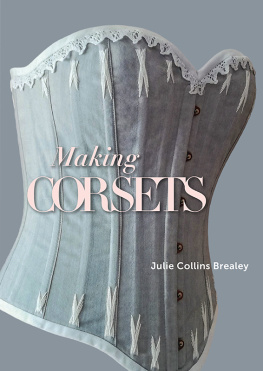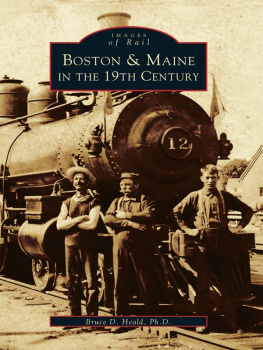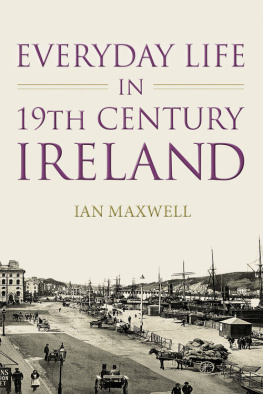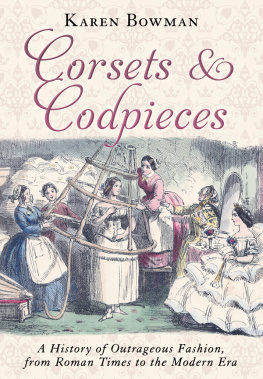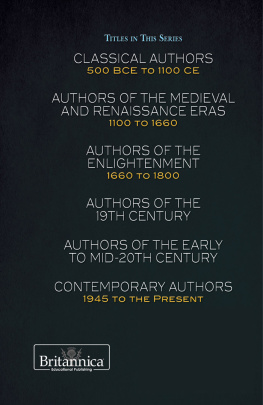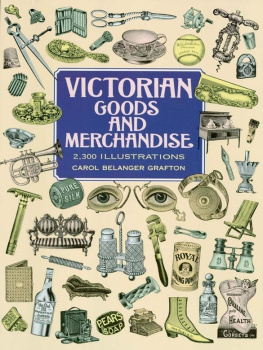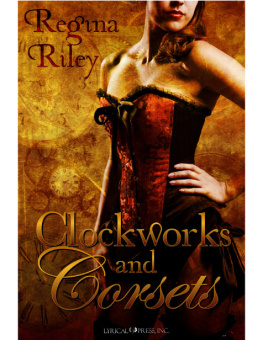BOUND & DETERMINED

A VISUAL HISTORY OF
CORSETS
18501960
K RISTINA S ELESHANKO

D OVER P UBLICATIONS , I NC .
M INEOLA , N EW Y ORK
Copyright
Copyright 2012 by Kristina Seleshanko
All rights reserved.
Bibliographical Note
Bound & Determined: A Visual History of Corsets, 18501960 is a new work,
first published by Dover Publications, Inc., in 2012.
International Standard Book Number
ISBN-13: 978-0-486-47892-0
ISBN-10: 0-486-47892-0
Manufactured in the United States by Courier Corporation
47892001
www.doverpublications.com
Introduction
It is the lesser blot, modesty finds,
Women to change their shapes, than men their minds.
William Shakespeare, Two Gentlemen of Verona
One of the highest entertainments in Turkey is having you go to their baths, aristocrat Lady Mary Wortley Montagu wrote in an 1850s edition of Godeys Ladys Book. When I was first introduced to one, the lady of the house came to undress meanother high compliment they pay to strangers. After she slipped off my gown and my stays, she was very much struck by the sight of them and cried out to the ladies in the bath, Come hither, and see how cruelly the poor English ladies are used by their husbands. You need not boast, indeed, of the superior liberties allowed to you when they lock you up in a box.
The box, which every American woman from colonial days through the 1950s came gift wrapped in, was the corset. To modern women, the idea of keeping house, shopping, rearing children, dancing, and even swimming and playing sports all while barely able to bend over in a corset seems impossible and even ridiculous. Why did women do that to themselves? we wonder.
The answer heard most often is vanity. Then, as now, few women were satisfied with their natural figure. Corsets were the only means of obtaining the currently-popular shape, whether it was the rigidly flat torso and raised bosom of the seventeenth century, the flat-stomached, high-busted, shoulders-back look of the eighteenth century, or the hourglass figure of the nineteenth century. In the early- and mid-twentieth century, corsets worked something like a rigid diet and hours in the gym do today, flattening the stomach and hips, and often trimming the waistline, too.
While many women did wear corsets for vanity, there were other reasons for putting on a corset. Bras didnt become popular until the 1930s, so corsets acted as a bosom support. Also, during many eras, womens clothes were skin tight; without a corset, bodices would have constantly wrinkled and ridden up.
Corsets also affected a womans demeanor. As one Victorian mother wrote to a fashion magazine, at first her daughter rejected the discipline of the corset but now her only objection is that the corsets are uncomfortable and prevent her from romping about... Which was exactly the point. Corsets altered more than the figure; they also affected the behavior and, it was believed, the character of the women who wore them.
Dress reformer Helen Gilbert Ecob, in her 1892 book The Well Dressed Woman, mentions this argument. She wrote: Those who uphold the corset argue its morality because the only period in which its general use appears to have been discontinued are the few years which immediately followed the French Revolution, when the general licentiousness of manners and morals was accompanied by a corresponding indecency in dress.
And to a great many women, not wearing a corset did seem indecent. Corsets in one form or another had been around since biblical times, and were adopted by nearly all women by the sixteenth century. Ecob claimed that by 1892 American women bought 60,000,000 corsets each year. After generations of dedicated corset wearing, many women were uncomfortable going withoutas if they were walking around naked.
Corsets always had their detractors. In the early days of corset wearing, many people condemned them as the artifice they were. Pastors and priests considered them a rejection of the naturally beautiful figure God gave woman, in addition to a device meant to snare men by calling attention to female sexuality.
Havelock Ellis, an early sexologist (who was himself sexually dysfunctional), wrote in 1923 that one of the main attractions of the corset was that it caused women to breathe in a shallow manner. This, in turn drew greater attention to the breasts, because they moved up and down in a more conspicuous manner. He also claimed he knew women who said they were in a constant state of arousal when they were tight laced.
Letters to the editor from the 1800s also show that some people found corsets sexual. One Victorian man wrote to a fashion magazine: There is something to me extraordinarily fascinating in the thought that a young girl has for many years been subjected to the strictest discipline of the corset. If she has suffered, as I have no doubt she has...it must be quite made up to her by the admiration her figure excited.
During the nineteenth century, doctors and laymen began suspecting a connection between womens notoriously delicate health and corset wearing. What a host of evils follows in the steps of tight-lacing, Victorian author Mary P. Merrifield wrote, indigestion, hysteria, spinal curvature, liver complaints, disease of the heart, cancer, early death! The further the century progressed, the more the evils of the corset were accepted as fact. Yet women continued corseting!
Some persistence in wearing corsets was due to ignorance. We have just received a letter, wrote the editor of Dress in 1888, in which the writer declares that a womans waist, left to itself, will grow larger and larger every year, until it measures nearly or quite as much as the bust!
But theres little doubt corset wearing also continued due to a desire for a new style undergarment that could both support the figure and make women feel less naked than they would sans corset. Corsets were so firmly entrenched in feminine life, it seemed impossible to live without them.
Babies and young children wore felt bands or waists to keep their chests warm. Girls as young as four wore training corsets, usually stiffened with cording. By the time a girl was twelve to fourteen, she could expect to graduate to a full-ledged corset. There were rust-proof corsets for swimming, short corsets for horseback riding, corsets with elastic inserts to make housekeeping chores easier, electric corsets that replaced whalebone with magnetic strips and claimed to ward off and cure diseases, nursing corsets, maternity corsetsa corset for every occasion. No wonder it seemed impossible to live without them!
What is most singular is that women are aware of the injuriousness of the corsetthey instinctively feel that its action is an unnatural and eminently hurtful one, a medical doctor wrote to Godeys Ladys Book in the 1860s. Here is the proof. If...a lady falls ill in a crowded assembly of any kind, a general cry is raised by the others, Cut her lace! This is done instantlythe compressing machine is opened, air rushes into the lungs, the victim breathes and recovers.
Yet the discomfort of the corset wasnt just due to restrictiveness. According to author Helen Gilbert Ecob, Dr. Robert L. Dickinson of Brooklyn conducted scientific studies showing just how much pressure corsets put on womens bodies, publishing his findings in an 1887 issue of the New York Medical Journal. The most physical pressure the doctor measured from a corset was eighty-eight pounds. The pressure of a loose corset, Ecob reported, is about thirty-five pounds. As she then points out, few women could lift a common sack of flour, yet a sack of flour weighs twenty-five poundsten pounds less than the pressure of the loosest corset.
Next page


